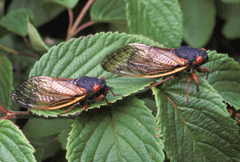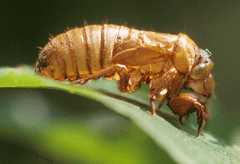Seventeen Year Cicada
Air Date: Week of June 22, 2007

Adult Cicadas (Courtesy of USDA)
After seventeen years of hibernation, the cicadas of Brood XIII in Illinois recently re-emerged. Commentator Tom Montgomery-Fate has been watching them in his backyard in suburban Chicago, with a sense of wonder about their--and our--purpose.
Transcript
GELLERMAN: It’s been a big sleep, but now they’re wide-eyed, bushy-winged and back in droves. In northern Illinois, the 17-year cicadas are re-emerging from their long underground snooze. And commentator Tom Montgomery-Fate has been watching them in his backyard in suburban Chicago wondering whether the cicada’s short but dramatic lives offer a bit of insight into our own.
MONTGOMERY-FATE: All spring I noticed the little holes appearing in our rose bed. They are the openings to the finger-sized mud chimneys where thousands of cicada nymphs had been waiting for the moment their bodies would “know” they should leave. After 17 years of waiting in the darkness and sipping from tree roots, the moment finally arrived.

Cicada nymph (Courtesy of USDA)
This explosion of cicada - roughly a half million of them per acre—has prompted a range of emotions from my neighbors - from joy to disgust. Some are repulsed by the swarms of bugs clinging to their bushes and flowers, or falling out of trees into their hair during an evening stroll.
But others, like me, see the cicada as the genius of nature: 17 years of patience, of waiting underground, followed by a few weeks of passion, of sunlight and sex, of birthing and dying. This seeming imbalance between patience and passion is misleading. The rare abundance of the cicada evolved to overwhelm their predators, who simply can’t eat them all. The patience and passion has a purpose, and it has worked for thousands of years.

Adult Cicadas (Courtesy of USDA)
I shift my attention back to the ancient chorus in the backyard, and strain to hear something hopeful amid the cacophony, something I can trust. I try to remember that we and the cicada are related, and to believe that that matters, and that it is never too late to crawl out of the darkness into the stunning possibilities of the sunlight.
[MUSIC: Sleepytime Gorilla Museum “The 17-Year Cicada” from ‘Of Natural History’ (Web Of Mimicry – 2004)]
GELLERMAN: Tom Montgomery-Fate teaches writing at College of DuPage in Glen Ellyn, Ill. He’s the author of the memoir, “Steady and Trembling.”
Links
Tom Montgomery-Fate, Professor of English, College of DuPage
Living on Earth wants to hear from you!
Living on Earth
62 Calef Highway, Suite 212
Lee, NH 03861
Telephone: 617-287-4121
E-mail: comments@loe.org
Newsletter [Click here]
Donate to Living on Earth!
Living on Earth is an independent media program and relies entirely on contributions from listeners and institutions supporting public service. Please donate now to preserve an independent environmental voice.
NewsletterLiving on Earth offers a weekly delivery of the show's rundown to your mailbox. Sign up for our newsletter today!
 Sailors For The Sea: Be the change you want to sea.
Sailors For The Sea: Be the change you want to sea.
 Creating positive outcomes for future generations.
Creating positive outcomes for future generations.
 Innovating to make the world a better, more sustainable place to live. Listen to the race to 9 billion
Innovating to make the world a better, more sustainable place to live. Listen to the race to 9 billion
 The Grantham Foundation for the Protection of the Environment: Committed to protecting and improving the health of the global environment.
The Grantham Foundation for the Protection of the Environment: Committed to protecting and improving the health of the global environment.
 Contribute to Living on Earth and receive, as our gift to you, an archival print of one of Mark Seth Lender's extraordinary wildlife photographs. Follow the link to see Mark's current collection of photographs.
Contribute to Living on Earth and receive, as our gift to you, an archival print of one of Mark Seth Lender's extraordinary wildlife photographs. Follow the link to see Mark's current collection of photographs.
 Buy a signed copy of Mark Seth Lender's book Smeagull the Seagull & support Living on Earth
Buy a signed copy of Mark Seth Lender's book Smeagull the Seagull & support Living on Earth

